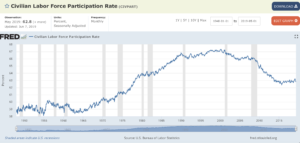Tweet [1]
Here are some data from FRED [2].
 Much is made these days of the “low” U.S. labor-force participation rate. Specifically, we are supposed to regard today’s very low unemployment rate of 3.6 percent skeptically. Despite having to go back to December 1969 [3] to find a monthly unemployment rate this low or lower (in 12/69 the rate was 3.5 percent), we are told that today’s nearly half-century low unemployment rate is overrated as an achievement because the U.S. labor-force participation rate is low. (Only persons participating in the labor force, but who are currently without employment, are counted as unemployed. Adults of working age who choose not to work are not counted as unemployed.)
Much is made these days of the “low” U.S. labor-force participation rate. Specifically, we are supposed to regard today’s very low unemployment rate of 3.6 percent skeptically. Despite having to go back to December 1969 [3] to find a monthly unemployment rate this low or lower (in 12/69 the rate was 3.5 percent), we are told that today’s nearly half-century low unemployment rate is overrated as an achievement because the U.S. labor-force participation rate is low. (Only persons participating in the labor force, but who are currently without employment, are counted as unemployed. Adults of working age who choose not to work are not counted as unemployed.)
Well.
Today’s (May 2019) labor-force participation rate of 62.8 percent is indeed lower than the all-time high rate of 67.3 percent that prevailed from January 2000 through April 2000, and lower also than it was for most of the first 13 years of the 21st century. But this rate today is higher, by 2.6 percentage points, than the 60.2 percent rate in December 1969 (the last month since the present day when the U.S. civilian unemployment rate was as low as it is today).
Note that today’s labor-force participation rate has been pretty steady for the past five years. (For example, in May 2014, this rate was 62.9.)
More significantly, note that today’s labor-force participation rate is well above its level for all of the years that many pundits, professors, and politicians – left, right, and center – routinely assert were the golden years for the American middle-class: the post-WWII years through the mid-1970s. Although falling somewhat from the mid-1950s through the mid-1960s, from the mid-1960s through 2000 the labor-force participation rate trended upward, although with a noticeable decline in its rate of increase starting in 1990. And yet for all of those post-WWII years until the late 1970s, the U.S. labor-force participation rate was lower than it is today.